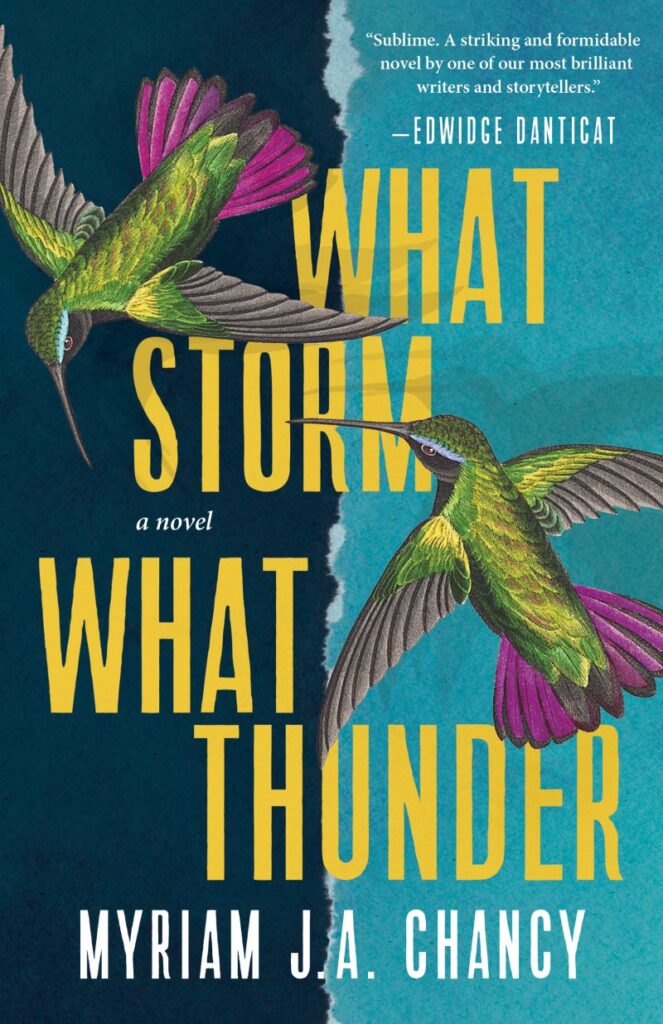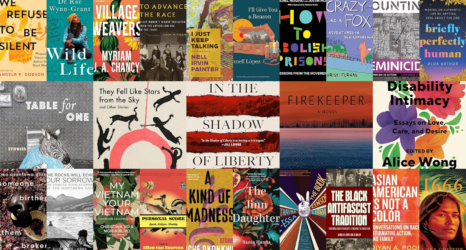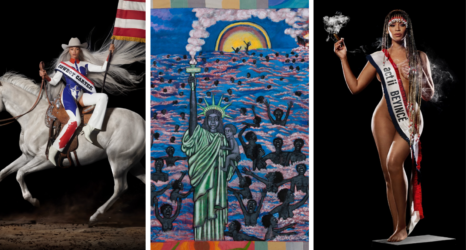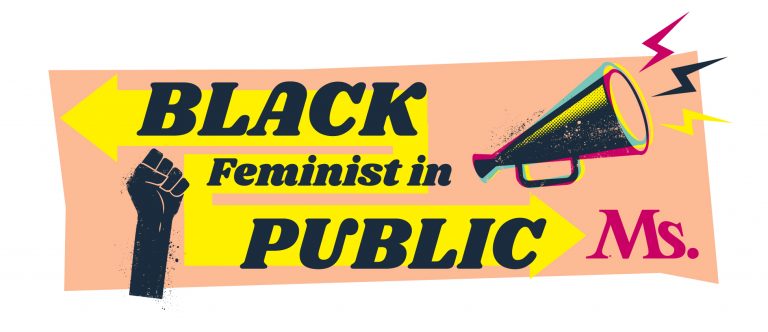
Black Feminist in Public is a series of conversations between creative Black women and Janell Hobson, a Ms. scholar whose work focuses on the intersections of history, popular culture and representations of women of African descent.
Born in Port-au-Prince, Haiti, the award-winning Haitian American/Canadian writer and scholar Myriam Chancy returns to her roots with her highly anticipated fourth novel, What Storm, What Thunder, due out next month. Chancy, a Scripps College professor, writes both scholarly works and fiction about Haitian and other Afro-Caribbean women. Her new novel, which commemorates the devastating January 12, 2010, earthquake that struck Haiti’s capital city of Port-au-Prince, killing 250,000 people, has taken on new relevancy with the recent August 14 earthquake on the island.
In a conversation with Ms.’s Janell Hobson, Chancy discussed her new novel, the fate of her birth island, and why more people need to listen to Haiti’s women.

Hobson: You’ve been writing your novel for quite some time, so there’s a certain irony that it would come out the year Haiti has yet another devastating earthquake. There were different tragedies, from the hurricane season to the presidential assassination. What are your thoughts on the current situation?
Chancy: It’s bittersweet, isn’t it? I mean, when I was working on the novel and taking my time with it—at least five, six years to get to the version I felt comfortable sending out—there was a moment where I felt this novel is going to become less and less relevant. But I remember my mother saying to me, “Don’t worry about when it comes out. There are people still writing novels about the second world war!” And there were so many lessons that we need to learn. One of the reasons I decided I would write the novel was because the situation was not getting better in Port-au-Prince.
Hobson: What are some of those lessons?
Chancy: People, different NGOs and other groups had decided Haiti was no longer relevant for their causes, but the people on the ground were still suffering. We still to date have something like 50,000 people who are in the IDP camps from the 2010 earthquake. The GDP per capita has not risen since 2010.
So even though billions poured into Haiti after 2010, it hasn’t changed the lives of many average Haitians. So, the novel was still relevant even before this summer. But we’ve had these calamities happen just recently, this assassination and the August 14 earthquake. What they highlight are all the infrastructural vulnerabilities that are still present on the island. And for many people, it brought back 2010 on an emotional, psychological level. There are some people who survived the 2010 earthquake who now have been through a second earthquake. The only hope right now is that the errors that were made after 2010 will not be repeated, but we already see some of them happening again.
Even though billions poured into Haiti after 2010, it hasn’t changed the lives of many average Haitians.
Hobson: What are you seeing specifically in this regard?
Chancy: The influx of foreign products, for example, rather than using the local products and using local staples so that they’re feeding into the Haitian economy. And then there are organizations that come to the island to help but don’t believe in listening to the local people. So, it is bittersweet for me because I would have wanted the novel to have been more of a reflection on what happened 11 years ago. But now it will probably reflect some of the experiences of people today and that’s unfortunate.
Hobson: With the recent earthquake, I saw an outrageous conversation on social media insinuating that the island is cursed. This thinking is tied up with a Christian worldview that demonizes Vodou. There is also, in terms of the African Diaspora, a love-hate relationship with Haiti in that context. We love the story of the Haitian Revolution, the only successful slave revolt in the Americas, but we don’t connect it with the present day.
Your novel opens with a Vodou invocation. How do we look at Haiti’s history and specifically Haitian Vodou culture in a way that is more revolutionary?
Chancy: The Haitian Revolution that everybody looks to for inspiration was in fact informed by the Vodou gathering in Bois Caiman, which ironically was also on August 14. And so, we can’t divorce one from the other. Vodou is a life force, and it very much has fueled the revolt and Haitian society since its inception. You can’t glorify the history but then dismiss the everyday poor Haitian who’s struggling today.
I’ve been telling people to just read a book and that’s the professor side of me. Mimerose Beaubrun’s book, Nan Domi, is helpful. Beaubrun is the lead singer of Boukman Eksperyans, whose music comes out of the Vodou experience, but she is also an anthropologist.
Some years ago, she wanted to publish her dissertation and her house burnt down and she had to start from scratch. So, she decided to go interview all the mambos, the priestesses, and it turned into a completely different book. She explores what is important in Vodou, what has been misunderstood about Vodou. And it also addresses the ways in which it has been cannibalized, both by the Duvalier regimes and by foreign entities. This is a very complex history that people need to unpack so they can unlearn their own negative feelings about it.
You can’t glorify the history but then dismiss the everyday poor Haitian who’s struggling today.
Hobson: What prompted you to write about the 2010 earthquake?
Chancy: Back in 2010, I wasn’t planning to write a novel at all. But I was called upon as a native of Port-au-Prince and a specialist in Caribbean women’s literature and women’s issues to give several talks. I was booked solid for six months after the earthquake, and that extended to three years of doing the work of educating people and writing polemical essays and strategies on the ground about what Haitians were calling for. Often when I gave those talks, there were Haitians in the audience who would speak to me afterwards about their experience of the earthquake. What I had spoken about had touched people who had been through the earthquakes themselves.
Hobson: Why did you explore these issues in novel form?
Chancy: I was a writer in residence in Trinidad at the University of the West Indies in 2012. I went back in 2013 and was introduced to LeRoy Clarke, a well-known Trinidadian painter. He was painting a series about Haiti, which he had started in 1986 at the end of the Duvalier regime but hadn’t finished that painting until after the earthquake. Then he went on to paint, I believe, 111 paintings in a cycle. When I met him, he had completed around 77 paintings.
I had a visceral experience with LeRoy who at the time had never been to Haiti. He did end up going to Haiti with the series a little bit later. When I understood that LeRoy had been called to paint on behalf of Haitians, I realized that I too had been hearing from Haitians all that time because they were speaking to me in the same way that people will speak to a physician about various ailments. People were talking to me because I’m a writer. And the expectation was that at some point I would be writing on this, not as a scholar, but as a creative. When I came home from that Trinidadian trip, I just sat down, and the novel just came to me.
People were talking to me because I’m a writer. And the expectation was that at some point I would be writing on this, not as a scholar, but as a creative. … I just sat down, and the novel just came to me.
Hobson: Your novel is told from the different perspectives of multiple characters. Was that the goal in capturing these different experiences of the Haitian earthquake?
Chancy: Yes. The story is told in 10 voices.
Initially I had 12 main characters, because on the ground people would say “January 12” or “the 12th,” or just “12,” to refer to the event. So, I wanted to have 12 individuals who represented the 250,000 lives lost, whose stories we’ll never know. I also wanted a wide range, in terms of age, gender, how different people reacted to the earthquake, because I know from my own family and my own reactions that there’s a wide range. Often what gets reported after major disasters is a kind of generalization of what the masses are going through, but not what individuals are going through. I wanted to capture that wide range. But I eventually ended up with a novel that was told through 10 voices, only one of which repeats. And that’s the voice of a market woman.
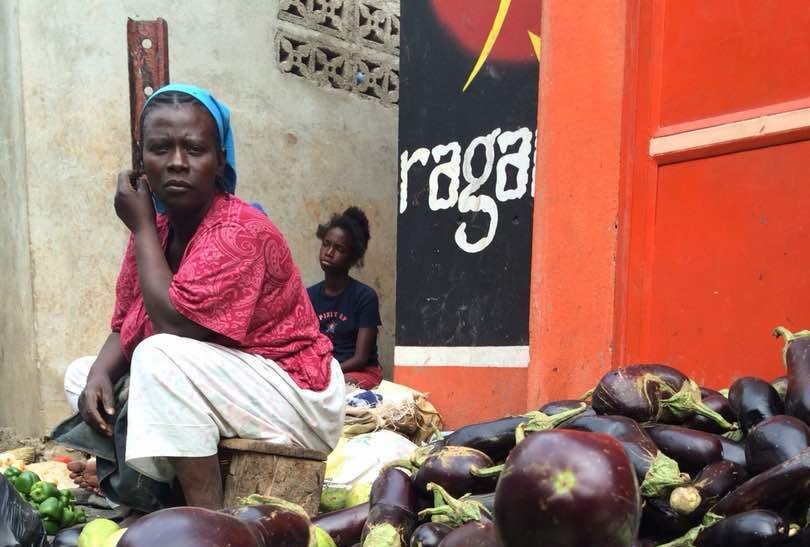
Hobson: In many ways, the Haitian market woman is an iconic image even as she’s simultaneously marginalized.
Chancy: Exactly. I’m the great-granddaughter of a market woman on my maternal side. I’ve always maintained that these are the people, the one group of people who need to be consulted the most about the future because when we’re not in a crisis, and people talk about Haiti, they often use the image of the market woman to show how hard Haitian women work as the pillars of society. And yet they never get consulted when it comes to decisions about the country. And these are women who take care of whole family groups. And, sometimes as my great-grandmother did, they are the ones who can rise out of poverty and lift others out with them. And that’s through concepts of collectivity, different Haitian principles.
I wanted a market woman to begin the book and end the book because market women know everything about the society. She’s the person who others are talking to in the novel. She knows about every character. They’re all interconnected in various ways, sometimes just through the marketplace. And that was the idea: to encapsulate a whole culture but doing it in a way that’s intimate and reflecting the greater whole.
When we’re not in a crisis, and people talk about Haiti, they often use the image of the market woman to show how hard Haitian women work as the pillars of society. And yet they never get consulted when it comes to decisions about the country.
Hobson: Would you say that this dovetails with a Black feminist consciousness?
Chancy: Yeah, sure. As a graduate student, I was always informed by Black feminist criticism and Afro-Caribbean women’s literature. In this novel, as I was speaking in terms of the market women, it’s reflecting not only a Black woman’s sensibility, an elderly woman’s sensibility since she’s in her 70s at the time of the earthquake, but also questions of class. Who do we listen to? Who do we consult?
But there’s also a young, adolescent girl who has a a significant voice in the novel. And then there is also a woman who is a sex worker and who defines herself as queer. I really try to give voice to the different ways in which women and girls are positioned in Haiti and to have them speak for themselves. There are also five male characters, but I’ve tried to infuse those characters with a Black feminist sensibility.
Hobson: How would listening to marginalized women make things better for Haiti?
Chancy: The problem is that we are stuck in this capitalist top-down model, where there is an external commission handling the funds coming into Haiti. And it hasn’t worked to not listen to the vulnerable. So why don’t we try something different? Because one of the things I know from my great-grandmother’s story, and I know from working more directly, in terms of listening to and championing and supporting grassroots organizations, is that they have a great deal of success on the micro level, who have built independent lives and incomes through micro loans and were able to hire other women in their own businesses, like my great-grandmother did. And that meant that those women could then send their children to schools. These children can send their children to the schools that could lead to university, for example, which is the case for my mother. So, those women, some of those women, have been able to break the cycle of poverty on the micro level.
So, I go back to my first point: We could reverse all of this by saying it has not worked to not listen to the people who know better about their own society and their own cultures. Why not try a different way, you know?
Hobson: Yes, and would you say that writing your novel allows us to listen to these voices?
Chancy: I think what fiction does is to give the reader an entry point at a very human level, a very intimate level. You’re invited into a conversation with a group of people. My hope is that the novel creates a conversation around that kind of intimacy so that the reader feels like now they know more about what happened in 2010, what might be happening now, and maybe they can think differently about where they donate or what they think about Haiti as a whole, and other small places in the Caribbean and elsewhere.
Up next:



